Street Closing on Arena Agenda
Murphy makes appointments to WCD board; City to retain naming rights for garage
The Common Council meeting Tuesday will pit Ald. Bob Bauman against the Barrett administration over plans to close off N. 4th St. for a pedestrian plaza.
Some months ago, Bauman expressed alarm that the proposal for a new Bucks arena would include a plan to close off N. 4th St. for one block between W. Highland and W. Juneau avenues. A permanent closure of the street would not be necessary, he said during an informal discussion held after a meeting of the Historic Third Ward Architectural Review Board.
Bauman was concerned that the closure of the street would provide a “dead zone” downtown, and inhibit movement and development. He suggested that the street be closed only for events, and that it could be configured to do so while serving as a plaza.
For example, he said, the street could be constructed with modified curbs — or, possibly none at all. Removable bollards could define traffic lanes, yet be whisked away when the plaza was in use.
The Bucks and the Barrett administration disagree with Bauman. Bucks president Peter Feigin says the facility would hold as many as 200 events during the year, arguing that it is best to simply close the street.
Bauman was able to insert an amendment into the proposed legislation that would keep the street open.
The Bauman amendment reads, in part, “Close N. 4th Street as needed using movable bollards under the authority of a special privilege permit (or other device to recognize the Bucks’ right to use the street).”
The full Common Council will consider it in the meeting to be held Tuesday, September 22nd. The matter is contained within measures calling for Tax Incremental Funding related to the arena development.
These include $27 million in borrowing for the Beerline TID #22 to construct an arena parking structure, $12 million in borrowing for TID #84 [West McKinley and West Juneau] for a plaza associated with the arena, and an additional borrowing of $8 million by TID #84 for the parking structure.
The block closing would retain a transportation easement for construction of a proposed streetcar line. Development Commissioner Rocky Marcoux said the benefits of the street vacation would outweigh the disadvantages.
Others disagree. “Vacating Fourth Street for a Bucks plaza would be drastic and risky,” said the headline of an open letter published today by a group of citizens, and researched by Virginia Small who has been a critic of the arena plan. The letter called on the full council to support Bauman’s plan “so that transparent planning and more study can be done around this important civic issue.” The group noted that temporary pedestrian plazas are created nightly in New Orleans on Bourbon St., and that they are “commonly done near sports venues in Indianapolis, Seattle and Boston.”
Milwaukee routinely closes streets for “festivals, Wisconsin Avenue night markets and Cathedral Square events.”
Among the signers was Julilly Kohler, a developer and officer with the Turner Hall Ballroom Preservation Trust. Her group has worked for decades to save the 1882 landmark which is located on N. 4th St. just south of W. Highland Ave. She feels that the street closure would create what she also calls “a dead zone,” and said that street closures almost inevitably fail. She noted the proposal of Marquette University to close a portion of W. Wisconsin Ave. as an example of a plan that died after public opposition, and hopes the same fate will befall the plan to close N. 4th St.
As for Turner Hall, the old building has benefited from an infusion of capital to rehabilitate its kitchen and bar areas, which are now leased by Major Goolsby’s. The building is also handicap accessible and has had fire sprinklers installed throughout. An arrangement with the Pabst and Riverside theaters has enabled the 7,000 square foot Turner Hall Ballroom to become a popular concert venue.
Yet the facility, located directly across the street from the Bradley Center is largely dependent on that arena’s schedule to generate business for the bar and restaurant. The operators and Turner Hall board would like to see an increase in street foot traffic, not a decrease, as may happen in the event the block to the north is closed.
Also, Urban Milwaukee has reported that the west side of downtown, with its larger blocks, already poses difficulties for planners, due to lack of intersections and the creation of “superblocks.”
The open letter also expressed concern that the closing of N. 4th St. would hinder efforts to develop the Bronzeville district to the north. For years this area, and N. Martin Luther King Blvd. were blocked off from downtown by an elevated freeway. A street closure, the letter argues, would block a natural path from the Intermodal Transit Station to Bronzeville and MLK Boulevard.
Text of open letter opposing street closure can be found here.
Update
Reached late Monday afternoon at his office, Bauman said his concern was that the city was being asked to “vacate a significant of public infrastructure without a plan.” The Bucks have only released very conceptual drawings of the proposed arena. These images were brought to the public in April, and nothing new has been made public or private, apparently.
Certainly Bauman has not seen anything new, he has confirmed. “I have seen no new renderings,” he said. At the signing of the option to purchase the arena site for $1 from Milwaukee County on September 9th, Bucks President Peter Feigin said detailed schematics would be available within a “few weeks.”
Bauman said the renderings would be essential for the city to make a decision on the vacation of the street. “It is possible it could work well, or be a disaster.” Streets, he said, “are part of the fabric of the community. The streets accommodate all kinds of traffic [pedestrian, vehicular, bicycle, transit, emergency]. I want to make sure it is done right, and I can’t tell [at this point.] … Before we plow ahead we should see what is going to happen to this place. The proposal will still have to go through the Zoning Neighborhoods and Development Committee, the Public Works Committee and the City Plan Commission,” he said, adding, “The public will have many opportunities to weigh in.” Bauman said “hopefully we will hear from architects and planners. Maybe we’ll even hear from John Norquist.”
Bauman admitted that the new arena represents “a very different development process” for the city, what with the state oversight and other factors. He feels there have been some missteps because the development is proposed by “out of towners who do not understand the local custom and process and who are maybe getting some bad advice.” He said that President Feigin and his staff “are genuine people who are doing their job and want to see things succeed.”
Parking Garage Revenue to be Split Between City and Bucks
In addition to deferring a decision on the strteet vacation, Bauman said late Monday that he also expects that the Common Council will approve a plan to split the revenues from the naming rights for a parking garage with the Bucks. The Bucks will market the naming rights, in exchange for half the revenue. The city’s share of the revenue will go to support the city’s fund for developing and improving its tot lots and play fields. The program is a pet project of council president Michael Murphy, who suggested that the naming rights revenue be dedicated to that purpose, Bauman said.
City to Retain Naming Rights
Eagle-eyed Bauman also seized on the opportunity for the City — and not the Bucks — to retain the revenue from naming rights for the proposed parking structure to be built for the arena.
The amendment reads: “City may sell naming rights or corporate sponsorship signage for the Parking Structure and retain all revenue associated with such naming or sponsorship.”
Bauman, Coggs, Murphy on Wisconsin Center District Board — So What?
Common Council President Michael Murphy appointed himself, 6th District Alderman Milele Coggs and 4th District Alderman Robert J. Bauman as interim members of the Wisconsin Center District Board on September 11th.
In a letter to Secretary Scott Neitzel, the State Department of Administration head who is the chair of the WCD board, Murphy also said that he feels there is not sufficient protection in the Bucks contract to penalize the team, and reimburse the taxpayers, in the event that the team relocates, and if the city is stuck with an unused arena and dead pedestrian plaza.
Murphy also strongly cautioned Neitzel to ensure that the bonds to be issued strictly be used for non-commercial portions of the development, so as not to jeopardize the bonds’ tax-exempt status.
But, to what avail?
Murphy also somewhat plaintively asked that the board be heard and be able to participate in the districts deliberations with the Bucks, but he did not sound very encouraging:
“While I recognize the State Legislature has bestowed on you, as interim chair, extraordinary power to execute these agreements without the approval of the board, I urge you to consult with, and seek approval from, the board throughout the negotiation process and prior to entering any agreements.”
Arena Renderings
Plenty of Horne
-
Villa Terrace Will Host 100 Events For 100th Anniversary, Charts Vision For Future
 Apr 6th, 2024 by Michael Horne
Apr 6th, 2024 by Michael Horne
-
Notables Attend City Birthday Party
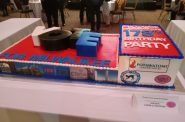 Jan 27th, 2024 by Michael Horne
Jan 27th, 2024 by Michael Horne
-
Will There Be a City Attorney Race?
 Nov 21st, 2023 by Michael Horne
Nov 21st, 2023 by Michael Horne


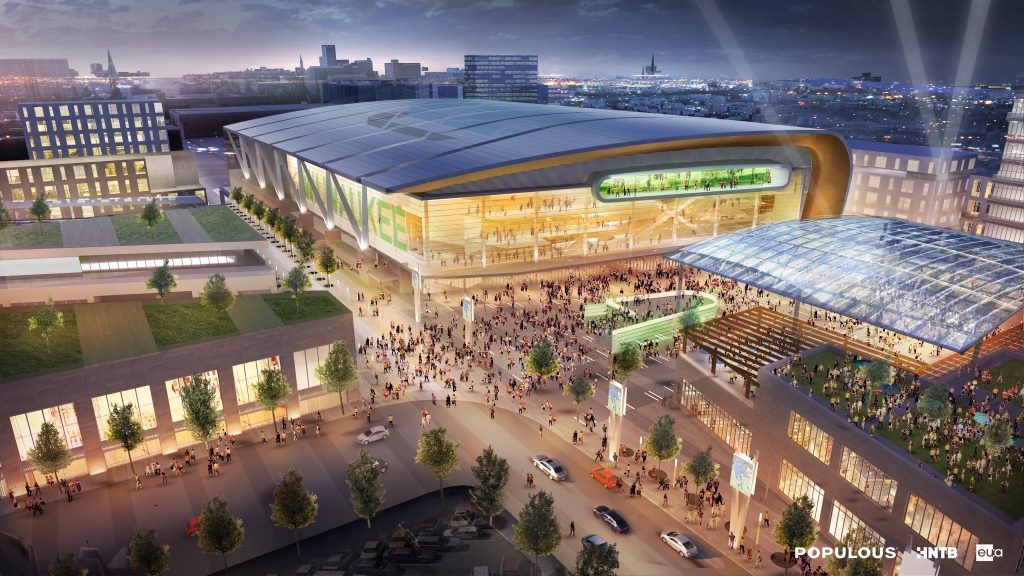
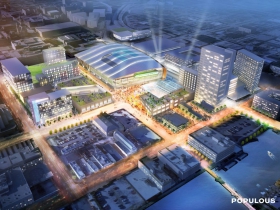
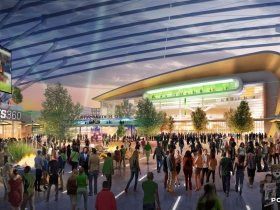
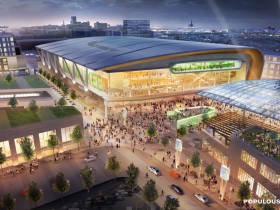
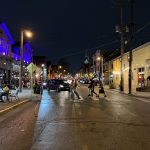

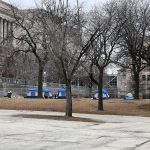

















I’m with Bauman on this one. I’m hoping a majority of the Common Council is as well. Let’s see if the Alderman whose district is actually affected by this amendment has the votes.
I, too, oppose the city vacating that right of way. Regardless whether the street is permanently closed to motor vehicles, or just closed to motor vehicles during arena events, the city should retain the right of way. It might make sense to pedestrianize that block, or it could become a shared street that permits motor vehicles but is designed in a way that essentially requires drivers to go very slowly and allows people on foot or bike to access the entire right of way.
Hope Bauman is defeated on this one. There’s no reason to keep the street open, it’s rarely used now and would deter the plaza being used all the time. Also, plazas are a major tenant of New Urbanism and a good thing to have. Also, unlike the city, these are businessman who won’t want to let the place be dead like a lot of city owned plazas since they’re the ones losing money.
Pedestrian malls only work where there’s already tons of people in an urban area. They don’t attract new people. Period. The rest is hype and fantasy..
Entertainment complexes around sports venues also do poorly in attracting traffic on non-event days/nights.
Feigin wants the arena to host 200 events a year. I bet Bradley Center staff does too–and then they swallow a dose of reality.
Bucks host about 41 games, 46 max? Marquette about 25? Admirals will be gone. So that leaves 130 dates to book. How many concerts does BC book now? Is it a dozen, 20? Even by some magic a new arena doubles that, you’re still a long way from 200. Unless you count every event with more than 100 people…Not worth closing a street for.
Also, why base closing 4th St. on what it is now when the big plan is to really build up Park East, including 4th St.? Short-term thinking for cities always causes problems…
Remember when all of the utility companies demanded that the City pay for the relocation costs of their facilities because of the streetcar? Do you think they will pass on those same relocation costs here? Unh-uh. A “simple” street vacation will end up costing many millions of Bucks.
“In addition to deferring a decision on the street vacation, Bauman said late Monday that he also expects that the Common Council will approve a plan to split the revenues from the naming rights for a parking garage with the Bucks. The Bucks will market the naming rights, in exchange for half the revenue. The city’s share of the revenue will go to support the city’s fund for developing and improving its tot lots and play fields. The program is a pet project of council president Michael Murphy, who suggested that the naming rights revenue be dedicated to that purpose, Bauman said.
Ald. Bohl said money for these rights for naming a city garage “is not the burger, not even the bun, but the crumbs from the bun” and the Greedy Bastards have rolled tough-guy Bauman for even this bit of taxpayers’ lunch money. The garage has already been nicknamed “Barrett’s Folly” by folks at a certain major-media outlet…So now Murphy wants to pretend to fund playgrounds with Monopoly money…Maybe each alder some will get a folly named for them…T
Street closures and superblocks have been the biggest factors destroying urban character and throttling the development progress of the Westown area, yet every time a big project comes along (Grand Avenue, Bradley Center, convention center, new Bucks arena) city leaders go ahead and allow closing another street. Barrett held his ground and got a fair Bucks deal for the city from a financial perspective, but he’s received some terrible advice from people in his administration on this plaza issue, just as he did on the Pabst City entertainment complex early in his administration. Let’s hope they see the obvious advantages of the plan that retains 4th street as a city right-of-way with a part-time plaza.
If they want a plaza they could build it to the south of the new arena. Highland Ave. is already closed in that area and the conceptual plans appear to keep it closed.
We have to remember, 5th Street is already non-existent. 6th and 3rd are the only other north south connections between I-43 and the river. As downtown continues to grow, and as the Park East and the multitude of opportunity sites around this area are developed, we will be in need of a variety of north south connections. We should be finding a way to increase the number of connections, rather than decrease. The strength of a robust street grid network is that it provides multiple ways to go. For instance, the next street construction cycle, if 4th street is eliminated, will mean that the area could be down to a single north south connection. More, not less connections is what we need downtown. I’m all for the redevelopment of an outward facing mixed-use stadium concept, but lts preserve a street. You can always close it off for an event.
Here’s definitive research on the fate of all pedestrian malls created since 1959 in the U.S. Done in 2013, it does not include Times Square, but that one epitomizes all key success indicators. The Bucks’ proposal has no indicator of success except that it’s one block–but it will have no drivers of traffic except chain bars and restaurants and a Bucks merch shop.
http://downtowndevelopment.com/pdf/americanpedmallexperiment.pdf
No pedestrian mall created in a dead zone has succeeded.
What about the Streetcar going up 4th Street to Bronzeville? It’s mapped out for a future phase, some unknown years down the road. If the Bucks build a pedestrian mall by closing off 4th what happens to that plan? Does it die? Or do we spend millions more to dig up and reconfigure a plaza built for $20-plus million? (Like we spend $35M to replace a productive garage?) Are there implications in running the Streetcar if the city does not own the street in that section?
The Bucks already swept their series and won all the other land grabs–getting 30 acres of public land. Let the city keep its street and close it off for 40-some Bucks games and maybe some concerts and maybe MU games.
@”M” The deal includes an easement for the streetcar. Not an issue. And I’m pretty sure the plaza cost is $12 million
John Norquist thinks closing 4th St. would be a big mistake…
http://www.bizjournals.com/milwaukee/blog/real_estate/2015/09/former-mayor-johnnorquist-bucks-should-back-off.html?ana=e_mil_rdup&s=newsletter&ed=2015-09-25&u=lDLSNHSRGH44pCkoaHAMHw0b930af3&t=1443193150
@Dave: Good to know about the Streetcar easement. But unless they build both at the same time (not likely based on projected schedules) there would likely be duplicative costs in ripping up infrastructure. A “Complete Streets” approach to 4th makes more sense.
Project costs on the entertainment plaza are fuzzy. Comptroller says there’s about $4.5M in extra infrastructure not included in the $12M, plus $1.5M in tear-down costs, plus $7.4M in appraised value for the 4th St. garage and site. In any accounting, it’s a very big bundle…
@”M” You don’t have to build both at the same time (certainly there would be some savings but). If utilities are moved (if they need to be moved) during the first part then the streetcar is really just a shallow cut between 12 and 18 inches. An example of this planning ahead is: The Saint Paul bridge. It was built with the streetcar in mind so it will not require a big redo when the project gets going (you can actually see on the bridge where the tracks go).
The other costs you’re attributing to the plaza are for other parts of the project. Next to or near the plaza, but not the plaza.
Didn’t Norquist also think keeping the bucks was a good idea?
@Dave,
Closing 4th St. is not about keeping the Bucks, and Norquist did not equate the proposed plaza and bar mall with them staying. The Bucks, city officials and others have all insisted on TOTAL COMPLIANCE of a top-down plan. “Top-down” is a discredited model–just like pedestrian-only malls. Community involvement is now considered essential to successful development (per Peter Park & others).
If the Bucks want to be neighborly and promote a “neighborhood” in Westown’s people-repelling Concrete Canyon, I hope they will present real options and engage the community–as the city does for other projects. So far it’s been their way or the highway–literally.
Various types of “Complete Streets” plans can accommodate everyone and keep the city’s planning from being forever hogtied.
I’m glad the Bucks are staying. I want more development in Westown and don’t want existing businesses to be cannibalized. It’s the job of city officials to play traffic cop and make sure everyone plays fair. Appeasement has been the city’s strategy thus far and sooner or later it will backfire.